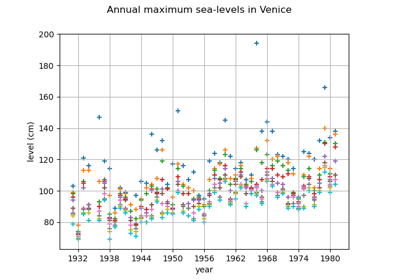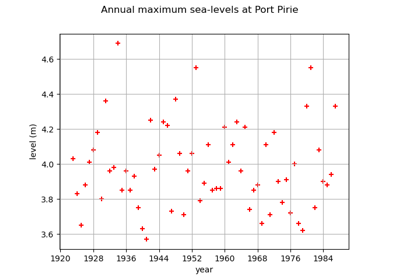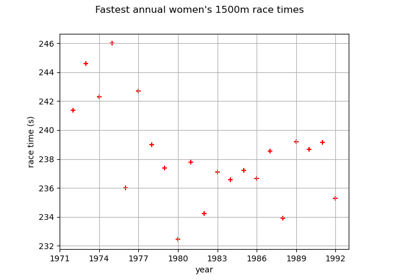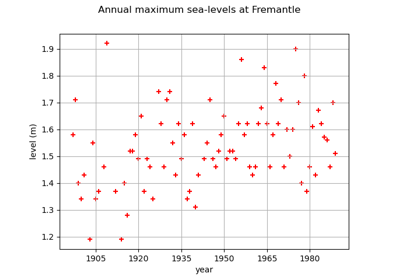GeneralizedExtremeValueValidation¶
- class GeneralizedExtremeValueValidation(*args)¶
Validation of GeneralizedExtremeValue inference.
Warning
This class is experimental and likely to be modified in future releases. To use it, import the
openturns.experimentalsubmodule.- Parameters:
- result
DistributionFactoryResult Inference result to validate.
- sample2-d sequence of float
Data on which the inference was performed.
- result
Methods
Draw the 4 usual diagnostic plots.
drawPDF()Draw the estimated density and the data histogram.
Draw the return level with confidence interval.
Accessor to the object's name.
Confidence level accessor.
getName()Accessor to the object's name.
hasName()Test if the object is named.
setConfidenceLevel(confidenceLevel)Confidence level accessor.
setName(name)Accessor to the object's name.
- __init__(*args)¶
- drawDiagnosticPlot()¶
Draw the 4 usual diagnostic plots.
- Returns:
- grid
GridLayout - Returns a grid of 4 graphs:
the QQ-plot,
the PP-plot,
the return level graph (with confidence lines),
the density graph.
- grid
Notes
The 4 graphs are the probability-probability plot, the quantile-quantile plot, the return level plot, the data histogram with the fitted model density.
If
denotes the ordered block maximum data and
the cumulative distribution function of the GEV distribution fitted on the data, the graphs are defined as follows.
The probability-probability plot consists of the points:
The quantile-quantile plot consists of the points:
The return level plot consists of the points:
and the points:
where
is the empirical
-block return level and
the
-block return level calculated with the fitted GEV.
- drawPDF()¶
Draw the estimated density and the data histogram.
- Returns:
- graph
Graph The estimated density and the data histogram.
- graph
- drawReturnLevel()¶
Draw the return level with confidence interval.
- Returns:
- graph
Graph The return level graph.
- graph
Notes
The return level plot consists of the points:
and the points:
where
is the empirical
-block return level and
the
-block return level calculated with the fitted GEV.
- getClassName()¶
Accessor to the object’s name.
- Returns:
- class_namestr
The object class name (object.__class__.__name__).
- getConfidenceLevel()¶
Confidence level accessor.
- Returns:
- levelfloat
Confidence level for the confidence lines.
- getName()¶
Accessor to the object’s name.
- Returns:
- namestr
The name of the object.
- hasName()¶
Test if the object is named.
- Returns:
- hasNamebool
True if the name is not empty.
- setConfidenceLevel(confidenceLevel)¶
Confidence level accessor.
- Parameters:
- levelfloat
Confidence level for the confidence lines.
- setName(name)¶
Accessor to the object’s name.
- Parameters:
- namestr
The name of the object.
 OpenTURNS
OpenTURNS



